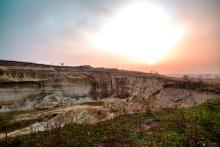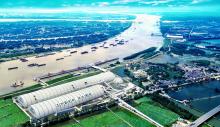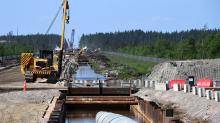The shortage of workforce in the EU since the beginning of the pandemic has not resulted in the suspension of large-scale infrastructure projects in the Balkan region which has ensured a relatively stable demand for aggregates.
For example, in Croatia this year the local government, together with private investors, plans to complete at least two major infrastructure projects which require significant aggregates supplies. The Peljesac bridge will connect the southern Peljesac peninsula to the mainland, while the building of the second tube of the Učka Tunnel is one of the most critical tunnelling projects in Croatia with an overall cost of HRK 1.5bn (€197.8mn). A significant part of building materials used in these projects is supplied from the Žminj quarry of Istria, one of the largest sources of crushed stone in Croatia.
Most local analysts expect the Croatian aggregates sector to ensure stable supplies of building materials for the needs of these projects, which will ensure their implementation on time.
According to an official spokesman of the Croatian Ministry of Economy and Sustainable Development (Ministarstvo gospodarstva i održivog razvoja) the pandemic did not harm the domestic aggregates sector. At the same time, the current situation remains stable. According to the Ministry, the Croatian government, from its standpoint, continues active support of the industry.
An official spokesman of the Ministry in an exclusive interview said: “According to the data for the first three quarters of 2020, there were no significant disturbances related to the exploitation of mineral raw materials (stone aggregates - technical-building stone and building sand and gravel) due to the COVID-19 epidemic. Among the other measures taken by the Republic of Croatia (due to the COVID-19 epidemic) during the current year, economic subjects- concessionaires in the business of mining were exempted from paying the variable part of the monetary concession fee for the exploitation of mineral resources."
According to the available data, the annual exploitation of mineral resources in the Republic of Croatia in 2020 does not significantly deviate from the five-year average. It is expected to maintain the same level or slightly increase in the following years.
Meanwhile, neighbouring Serbia's aggregate sector remains stable, which is reflected by the constant demand for aggregates in the local market.
Moreover, as the demand for aggregates in Serbia grows, many leading local producers have announced their significant operations and output plans for 2021. As part of these plans, some local companies specialising in aggregates mining have announced their plans to expand their special machines and heavy equipment fleet. One of them is Belgrade-based Teko Mining - part of the Austrian company of the same name. One of the largest producers of building stone in the country, an operator of six quarries with a total capacity of three million tonnes a year, Teko Mining (Serbia) has recently completed the purchase of at least two Caterpillar loaders for its mining operations.
As in Croatia, the implementation of the majority of large-scale infrastructure projects in Serbia is ongoing, contributing to maintaining a stable demand for aggregates in the local market even amid the COVID-19 pandemic and associated quarantine measures.
According to some Serbian media reports a significant part of current domestic aggregates output is going on the construction of a high-speed road linking Valjevo to Milos Veliki motorway, part of European transport Corridor XI, a ferry/motorway corridor linking Italy's Bari to Romania's Bucharest via Montenegro's Bar port and Serbia's Belgrade.
At present, aggregates, particularly stone, sand and gravel and other metals, account for 10% of the Serbian mining sector.
In Slovenia, another notable Balkan state, local analysts state that the demand for aggregates among local customers remains strong, despite a new set of government quarantine measures implemented in recent months.
Dr. Gorazd Žibret, an expert at the Department for Mineral Resources and Geochemistry of the government of Slovenia, said that despite strict national quarantine restrictions, he expects continuing infrastructure development to increase the demand for aggregates both in Slovenia and other countries of the region in 2021.
According to Žibret, in 2019 10.987mn tonnes of aggregates were produced in Slovenia. While 2020 data is still to be published, Zibret and other local analysts expect similar volumes to 2019. However, Žibret expects significantly higher Slovenian aggregates production output in 2021.
Most of the independent European analysts in the aggregates business also believe the overall situation in the aggregates sector of the Balkan states remains stable.
Jim O'Brien, an honorary president of UEPG (the European Aggregates Association), said: "In general, I can say that COVID-19 led to only a 5% loss in Europe on aggregates in 2020 compared to 2019. This shows enormous resilience in the industry gained through safe working protocols. The general sentiment in the Balkan region is one of positive growth, though Albania is more negative."
O'Brien and other local analysts interviewed believe the Balkans aggregates market will show good dynamics this year. The biggest regional growth rates are expected to be seen in Bosnia and Herzegovina and Kosovo. In Bosnia and Herzegovina (BiH), particular hopes of local producers and analysts are placed on the existing national mine strategy for 2018–25, adopted by the Council of Ministers in January 2019, which regulates the development of the country's aggregates sector until 2025.
Producers confirm these analysts' predictions. According to Guglielmo Benini, general manager of Gradient, Serbian producer, processor and distributor of fresh concrete and natural river aggregate, the demand for aggregates grows thanks to the growth of Serbia's construction sector and that of other Balkan countries.
According to Serbian Monitor, a Serbian business paper, the state and local producers have made significant efforts to discover new aggregates mines, ensuring the environmental protection of the surrounding areas of any newly discovered fields.
In recent years, the importance of ecology issues to the Balkans aggregates sector has significantly increased. One of the reasons for this has been the uncontrolled development of some major aggregates fields in the region, which has led to some ecological problems, particularly in Bulgaria.
Despite concerns over ecological issues, some local governments in Bulgaria are working hard to attract national and foreign investment in the country's aggregates industry. Several contracts have already been signed, the latest being a concession for 35 years, secured at the end of December 2020 between the Bulgarian government and Montana-based company Patishta M. Under the contract's terms, the US company received exclusive rights to develop the Lemishte aggregates field. According to the Bulgarian government's press service, during the concession contract term, the concessionaire is expected to pay over 1.2mn levs (€613,500) in fees and invest some 675,000 levs (€345,000) in the production of sand and gravel from the site.
The Lemishte field is in Boytchinovtsi municipality in the northwestern part of Bulgaria. It remains one of the largest aggregates fields in that part of the country.
Despite the COVID-19 pandemic, the Balkan aggregates sector's attractiveness to both domestic and foreign investors remains high. Such a sentiment is expressed, for example, in a recent US Department of Commerce's International Trade Administration report. Furthermore, the building materials sector in Montenegro remains one of the fastest-growing sectors of the country's economy.
In addition to attention paid to environmental issues, the ever-growing investments in energy and resource efficiency measures in recent years have become another essential feature of the Balkan aggregates sector.
The EU supports the efforts of regional mining companies in this field by providing loans and other financial support to implement these plans. Probably the biggest of such loans was €15mn supplied several years ago by the EBRD (European Bank for Reconstruction & Development) to Salonit Anhovo, Slovenia's leading, vertically integrated producer of building materials.









